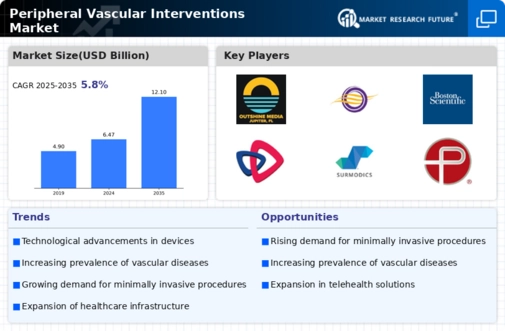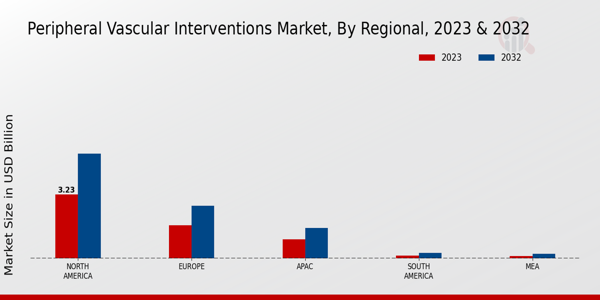Growing Geriatric Population
The demographic shift towards an older population is a significant factor driving the Peripheral Vascular Interventions Market. As individuals age, the risk of developing peripheral vascular diseases escalates, leading to a heightened need for effective interventions. Current statistics suggest that the geriatric population is expected to double by 2050, which will likely result in an increased incidence of PVD. This trend compels healthcare systems to adapt and expand their vascular intervention capabilities. Consequently, the Peripheral Vascular Interventions Market is anticipated to experience robust growth, as providers seek to cater to the unique needs of older patients, including tailored treatment options and comprehensive care strategies.
Increased Focus on Preventive Healthcare
The shift towards preventive healthcare is reshaping the landscape of the Peripheral Vascular Interventions Market. As awareness of the importance of early detection and intervention grows, healthcare providers are increasingly prioritizing preventive measures. This trend is reflected in the rising investments in screening programs and patient education initiatives aimed at reducing the incidence of peripheral vascular diseases. Market analysis indicates that preventive strategies can significantly lower healthcare costs associated with advanced disease management. As a result, the Peripheral Vascular Interventions Market is likely to benefit from this proactive approach, with an emphasis on early intervention leading to improved patient outcomes and reduced long-term healthcare expenditures.
Regulatory Support for Advanced Therapies
Regulatory bodies are playing a crucial role in fostering innovation within the Peripheral Vascular Interventions Market. Supportive regulatory frameworks facilitate the approval and adoption of advanced therapies and devices, thereby accelerating market growth. Recent initiatives aimed at streamlining the approval process for novel interventions have encouraged manufacturers to invest in research and development. This regulatory environment not only enhances patient access to cutting-edge treatments but also stimulates competition among industry players. As a result, the Peripheral Vascular Interventions Market is expected to witness a surge in new product launches and technological advancements, ultimately benefiting patients and healthcare providers alike.
Rising Incidence of Peripheral Vascular Diseases
The increasing prevalence of peripheral vascular diseases (PVD) is a primary driver for the Peripheral Vascular Interventions Market. Factors such as an aging population, sedentary lifestyles, and rising obesity rates contribute to this trend. According to recent estimates, PVD affects millions worldwide, leading to a growing demand for effective treatment options. This surge in patient numbers necessitates advanced intervention techniques, thereby propelling market growth. As healthcare providers seek to address these challenges, the Peripheral Vascular Interventions Market is likely to expand, with innovative solutions being developed to meet the needs of this patient demographic. Furthermore, the economic burden associated with untreated PVD underscores the urgency for timely interventions, further stimulating market dynamics.
Technological Innovations in Interventional Devices
Technological advancements in interventional devices are significantly influencing the Peripheral Vascular Interventions Market. Innovations such as drug-eluting stents, bioresorbable scaffolds, and advanced imaging techniques enhance the efficacy and safety of procedures. The introduction of minimally invasive techniques has also transformed treatment paradigms, allowing for quicker recovery times and reduced hospital stays. Market data indicates that the adoption of these technologies is on the rise, with a projected compound annual growth rate (CAGR) of over 8% in the coming years. As healthcare providers increasingly embrace these innovations, the Peripheral Vascular Interventions Market is poised for substantial growth, driven by the demand for improved patient outcomes and operational efficiencies.



















Leave a Comment